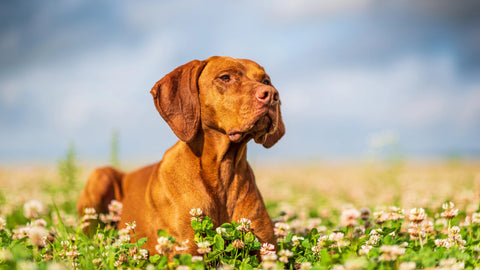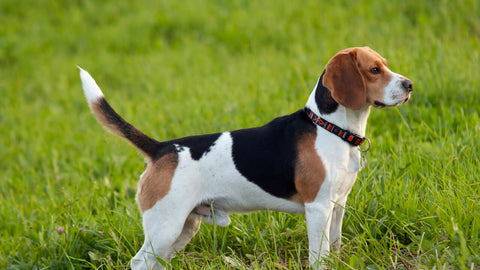Contents
- Introduction to the Magyar Vizsla
- Appearance of the Magyar Vizsla
- Coat and colours of the Magyar Vizsla
- How big can a Magyar Vizsla get
- The character of the Magyar Vizsla
- Training the Magyar Vizsla
- For whom is the Magyar Vizsla suitable
- Is the Magyar Vizsla a family dog
- Grooming the Magyar Vizsla
- Feeding the Magyar Vizsla
- How much does a Magyar Vizsla shed
- How old does a Magyar Vizsla get
- Typical diseases of the Magyar Vizsla
- How much does a Magyar Vizsla puppy cost
- What to look for when buying a Magyar Vizsla
- Profile of the Magyar Vizsla
Introduction to the Magyar Vizsla
The Magyar Vizsla, also known as the Hungarian Pointer, is an elegant, versatile hunting dog breed that originated in Hungary. With their exceptional intelligence, friendly nature and tireless work ethic, they are a popular companion for hunters and families alike. The Vizsla is characterised by its close bond with its humans and needs both physical and mental stimulation to be happy and balanced. Due to its engaging character and versatile range of uses, it has become a popular breed in many countries, including Germany, Austria and Switzerland.
Appearance of the Magyar Vizsla
The Magyar Vizsla is a medium-sized, athletically built dog with an elegant yet powerful appearance. Its body is muscular and well proportioned, giving it a special grace and agility. The head is dry and finely modelled, with a slightly domed skull and a pronounced stop. The ears are medium-sized, thin and set low, lying close to the cheeks. The Vizsla's eyes are almond-shaped and a warm amber colour, which gives its expression an air of intelligence and gentleness. The tail is usually docked halfway down, where this is permitted, and carried in a slight curve.
Coat and colours of the Magyar Vizsla
The Magyar Vizsla has a short, dense, and smooth coat that clings closely to the body. It feels slightly oily, which gives it a certain water resistance. The colour varies from different shades of a warm, golden, rusty brown, also called ‘bread roll yellow’. This coat colour is a characteristic feature of the breed and contributes to their unique appearance. There are both short-haired and wire-haired varieties of the Vizsla, with the wire-haired variety having a slightly rougher coat that provides additional protection.
How big can a Magyar Vizsla grow?
A Magyar Vizsla usually reaches a height of 54 to 64 cm at the withers, with males usually being slightly larger and stronger than females. The weight is usually between 20 and 30 kg, depending on gender and individual constitution. Despite their size, Vizslas never appear cumbersome, but retain their slim, athletic build.
The character of the Magyar Vizsla
The Magyar Vizsla is an extremely intelligent and sensitive dog that develops a close bond with its humans. It is known for its friendliness, affectionate nature and desire to please its owner at all times. Vizslas are very energetic and have a pronounced need for exercise and mental stimulation. They are often very playful and love spending time outdoors. Due to their high learning ability and strong hunting instinct, they are able to learn complex tasks, but require a sensitive and consistent upbringing.
Training the Magyar Vizsla
Training a Magyar Vizsla requires patience, consistency and empathy. Since Vizslas are very intelligent and sensitive, they respond best to positive reinforcement and loving consistency. Harsh training methods are counterproductive with this breed, as they can easily become insecure. Early socialisation and a varied training programme are important to get a handle on unwanted behaviour such as excessive barking or hunting instincts. Due to their willingness to work, Vizslas are excellent for dog sports such as agility, obedience or dummy training.
For whom is the Magyar Vizsla suitable?
The Magyar Vizsla is ideal for active people who spend a lot of time outdoors and can challenge their dog both physically and mentally. They are well suited to sporty families who enjoy outdoor activities such as jogging, hiking or cycling. The Vizsla is also an excellent choice for hunters or people who want to do dog sports. However, due to their sensitive nature, they should not be introduced into a family where there is too much stress or hustle and bustle.
Is the Magyar Vizsla a good family dog?
Yes, the Magyar Vizsla can be an excellent family dog, provided it gets enough exercise and mental stimulation. It is very affectionate and loves to be part of family life. Due to its sensitivity, it is particularly careful around children, but they should have learned how to treat dogs respectfully. The Vizsla needs close contact with its family and should not be left alone for too long.
Grooming the Magyar Vizsla
Grooming the Magyar Vizsla is relatively straightforward. Its short coat only needs to be brushed occasionally to remove dead hairs. During the moulting season, more frequent brushing may be necessary. Regular ear and dental care, as well as trimming their claws, are also part of their grooming routine. With the wire-haired variety, it is also important to trim their fur regularly.
Nutrition of the Magyar Vizsla
A balanced diet is very important for the Magyar Vizsla to maintain its health and performance. High-quality dog food with a high proportion of meat and little grain is recommended. Since Vizslas can be prone to allergies, care should be taken to ensure that their food is free from artificial additives and allergens. The amount and composition of food should be adapted to the dog's level of activity.
How much do Magyar Vizslas shed?
The Magyar Vizsla is one of the dog breeds that sheds relatively little. Its short coat is easy to care for, and even during the moulting season, the amount of hair loss is limited. Regular brushing can help to remove the few hairs that do fall out and minimise the amount of hair in your home.
What is the average age of a Magyar Vizsla?
The average life expectancy of a Magyar Vizsla is around 12 to 15 years. However, with good care, a balanced diet and sufficient exercise, a Vizsla can live to an older age. Regular veterinary check-ups and species-appropriate care also help to ensure that the dog has a long and healthy life.
Typical diseases of the Magyar Vizsla
The Magyar Vizsla is an overall robust and healthy dog breed. However, there are some breed-typical diseases that owners should be aware of. These include hip dysplasia (HD), epilepsy, allergies and various eye disorders such as cataracts. Responsible breeding with health screening of the parent animals can help minimise the risk of such diseases.
How much does a Magyar Vizsla puppy cost?
The cost of a Magyar Vizsla puppy varies depending on the breeder, pedigree and region. In general, the price is between CHF 1500.00 and CHF 2500.00. Reputable breeders place a high value on the health, socialisation and breed-typical characteristics of their puppies, which is reflected in the price. In addition, you should plan for the running costs of food, grooming and veterinary care.
What to look out for when buying a Magyar Vizsla?
When buying a Magyar Vizsla puppy, you should look for a reputable breeder who is a member of a recognised breeding association. The breeder should have a transparent breeding programme and be able to provide evidence of health checks on the parent animals. The puppy should grow up in a clean, loving environment and be well socialised. It is recommended that you get to know the puppy and its mother at an early stage to get an impression of the animals' character.
Magyar Vizsla profile
Breed: Magyar Vizsla (Hungarian Pointer)
Origin: Hungary
Size: 54 - 64 cm
Weight: 20 - 30 kg
Coat: Short, dense, smooth or wire-haired
Colour: Various shades of rusty brown
Life expectancy: 12 - 15 years
Character: Intelligent, sensitive, affectionate, keen to work
Special features: Strong bond with humans, loves to move, good hunting dog
Suitable for : Active people, sporty families, dog sports
Care: Easy, regular brushing and care of ears, teeth and claws
Nutrition: High-quality food, adapted to activity level
Typical diseases: Hip dysplasia, epilepsy, allergies, eye diseases




Comments (0)
There are no comments for this article. Be the first one to leave a message!